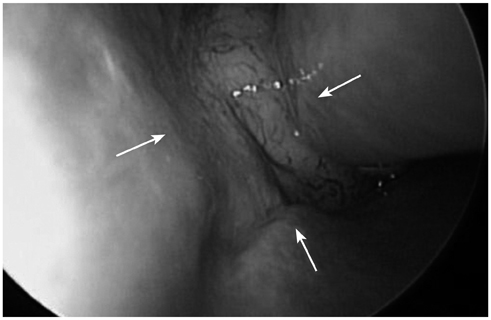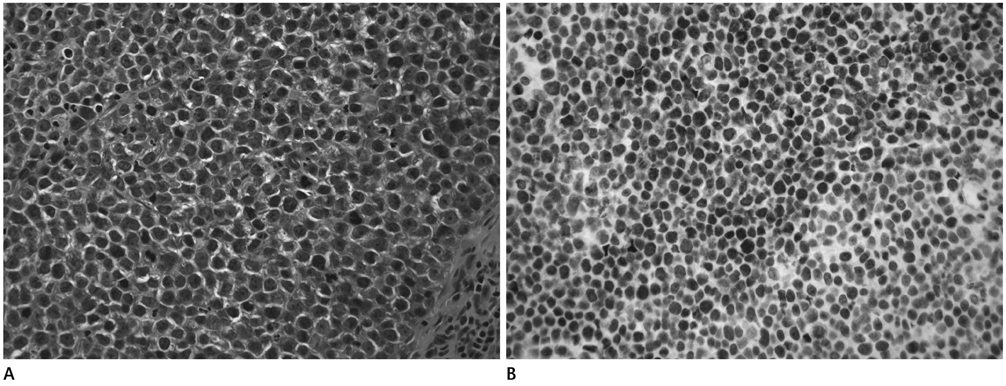J Korean Soc Radiol.
2013 Aug;69(2):99-103. 10.3348/jksr.2013.69.2.99.
Extraskeletal Primary Ewing's Sarcoma in the Nasal Cavity: A Case Report
- Affiliations
-
- 1Department of Radiology, Dongguk University College of Medicine, Ilsan Hospital, Goyang, Korea. ejl1048@hanmail.net
- 2Department of Otolaryngology, Dongguk University College of Medicine, Ilsan Hospital, Goyang, Korea.
- 3Department of Pathology, Dongguk University College of Medicine, Ilsan Hospital, Goyang, Korea.
- KMID: 2208812
- DOI: http://doi.org/10.3348/jksr.2013.69.2.99
Abstract
- Ewing's sarcoma presents a rare tumor of the head and neck, and even rarer in the nasal cavity and/or paranasal sinuses. We report the case of Ewing's sarcoma in the nasal cavity, as presented with nasal obstruction and epistaxis. The CT and MRI examination reveals a mass in the left nasal cavity with extension to contralateral side, ethmoidal sinus, and nasopharynx. We provide an overview of Ewing's sarcoma in the nasal cavity and discuss radiologic findings of this unusual case.
Figure
Reference
-
1. Kawabata M, Yoshifuku K, Sagara Y, Kurono Y. Ewing's sarcoma/primitive neuroectodermal tumour occurring in the maxillary sinus. Rhinology. 2008; 46:75–78.2. Aferzon M, Wood WE, Powell JR. Ewing's sarcoma of the ethmoid sinus. Otolaryngol Head Neck Surg. 2003; 128:897–901.3. Harman M, Kiroğlu F, Kösem M, Unal O. Primary Ewing's sarcoma of the paranasal sinus with intracranial extension: imaging features. Dentomaxillofac Radiol. 2003; 32:343–346.4. Howarth KL, Khodaei I, Karkanevatos A, Clarke RW. A sinonasal primary Ewing's sarcoma. Int J Pediatr Otorhinolaryngol. 2004; 68:221–224.5. Javery O, Krajewski K, O'Regan K, Kis B, Giardino A, Jagannathan J, et al. A to Z of extraskeletal Ewing sarcoma family of tumors in adults: imaging features of primary disease, metastatic patterns, and treatment responses. AJR Am J Roentgenol. 2011; 197:W1015–W1022.6. Csokonai LV, Liktor B, Arató G, Helffrich F. Ewing's sarcoma in the nasal cavity. Otolaryngol Head Neck Surg. 2001; 125:665–667.7. Yeshvanth SK, Ninan K, Bhandary SK, Lakshinarayana KP, Shetty JK, Makannavar JH. Rare case of extraskeletal Ewings sarcoma of the sinonasal tract. J Cancer Res Ther. 2012; 8:142–144.8. Coskun BU, Cinar U, Savk H, Basak T, Dadas B. Isolated maxillary sinus Ewing's sarcoma. Rhinology. 2005; 43:225–228.9. Gupta S, Gupta OP, Mehrotra S, Mehrotra D. Ewing sarcoma of the maxilla: a rare presentation. Quintessence Int. 2009; 40:135–140.10. Iezzoni JC, Mills SE. "Undifferentiated" small round cell tumors of the sinonasal tract: differential diagnosis update. Am J Clin Pathol. 2005; 124:S110–S121.
- Full Text Links
- Actions
-
Cited
- CITED
-
- Close
- Share
- Similar articles
-
- Primary Intradural Extraosseous Ewing's Sarcoma
- Extraskeletal Neoplasm Resembling Ewing's Sarcoma: Case Report
- Extraskeletal Ewing's Sarcoma: A Case Report
- A Case of Primary Ewing's Sarcoma of Arising from the Nasal Cavity
- Primary Extraskeletal Ewing Sarcoma, Initially Misdiagnosed as a Neurogenic Tumor




